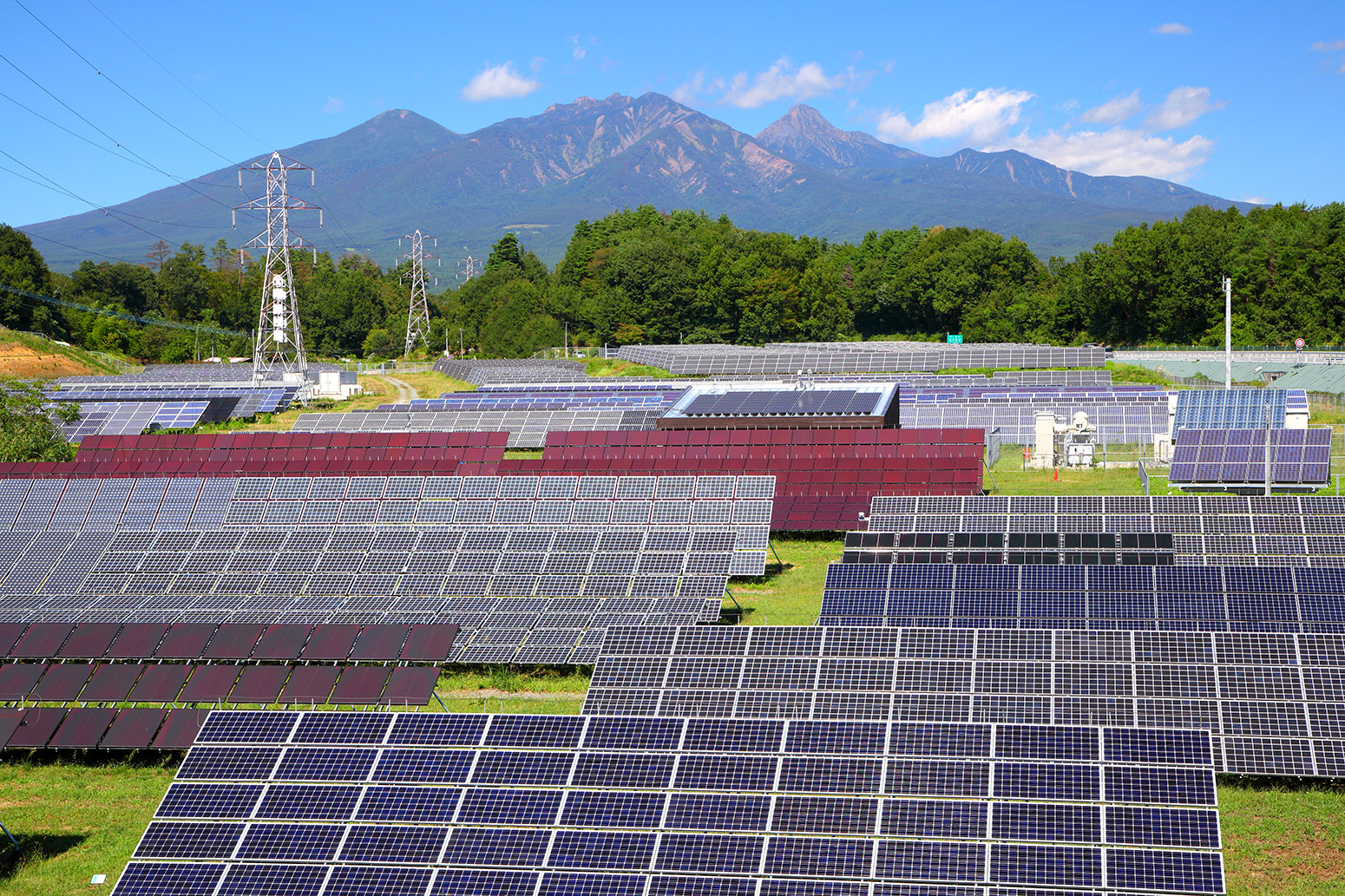
In the third article of a new series on how key emitters are responding to climate change, Carbon Brief looks at Japan’s gradually falling emissions and the ongoing legacy of the Fukushima nuclear disaster.
Japan is the world’sthird largesteconomy andseventh largestemitter of greenhouse gases (GHGs). Its plans for decarbonisation were significantly set back after the 2011Fukushima nuclear disasterled it to move away from nuclear power and expand the use of fossil fuels.
Japan’s government now plans to increase both renewable and nuclear power. However, it also intends to build significant numbers of new coal power plants. Japan has pledged a 26% reduction in GHG emissions below 2013 levels by 2030.
(Update 30/03/2020: Japan’s updatednationally determined contributionhasmerely reaffirmedits 2015 target of cutting emissions by 26%, despite pressure from the international community to ramp up ambition. In its “disappointing” submission to the United Nations Framework Convention on Climate Change, or UNFCCC, Japan also said it will “pursue further efforts” to reduce emissions beyond this level.)
(Update 26/10/2020: Prime minister Yoshihide Suga has pledged to cut Japan’s greenhouse gas emissions to net-zero by 2050 in his first policy address to parliament since taking office in September. The move was described byReutersas a “major shift” in the nation’s position on climate change, as it sets an explicit date for decarbonisation rather than the relatively vague commitments made previously (see below). Sugasaidhe would reduce Japan’s reliance on coal and promote both renewables and nuclear energy. The prime minister mentioned both “net-zero greenhouse gas emissions” and “carbon neutrality” in his speech, butClimate Action Trackerhas clarifiedthat the former is likely the government’s target.)
Politics in Japan
Japan has been a significant regional power for centuries, in particular since the early 1900s. It emerged as a major economic player in the decades following the second world war. Only the US and China now havelarger economies.
Japan is a parliamentary democracy, but the conservative Liberal Democratic Party (LDP) has governed almost continuously since it was formed in 1955. Its current leader, Shinzō Abe, has been prime minister since 2012 and in 2016wona snap general election. The next general election is set to take place by October 2021.
In 1997, Japan hosted the third formal meeting of the UNFCCC (United Nations Framework Convention on Climate Change) in Kyoto, its former capital. Here, it helped broker the adoption of theKyoto Protocol, the first international treaty to reduce emissions, whichtook into accountcountries’ historical contribution to climate change and ability to implement policies. However, Japan’s own climate efforts have beencriticisedas inadequate.
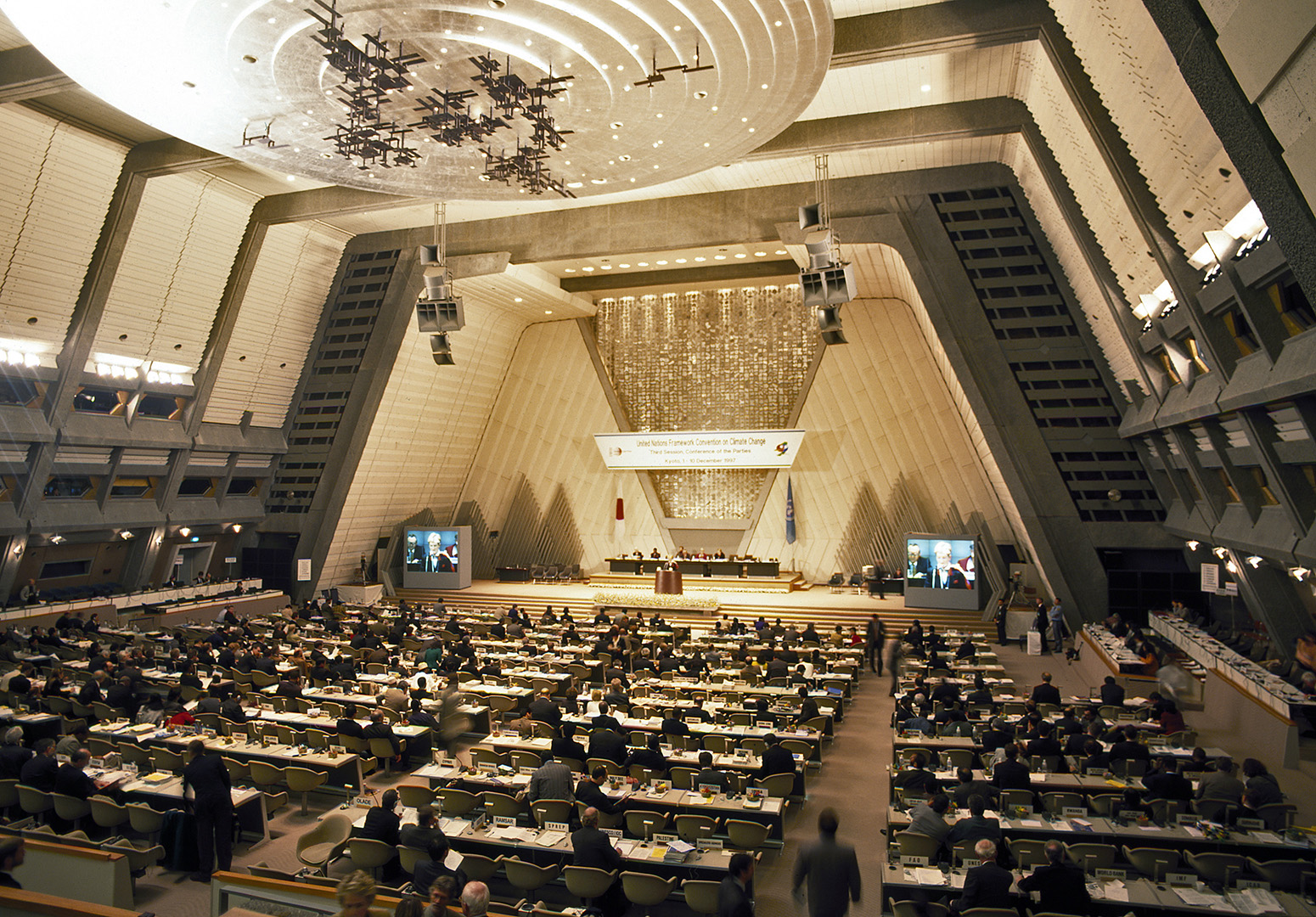
Plenary session in the main hall of the Kyoto International Conference Center at COP3, in 1997. Credit: UN Photo/Frank Leather.
After the 2011Fukushima disaster, in which a tsunami devastated a nuclear power plant, all of Japan’s nuclear reactors were switched off. Political and publicattentionturned to energy saving and alternative sources of power. Japan was also recovering from the damage of the majorearthquakeand tsunami, which cost 16,000 lives. This led to ambitious climate policy becomingless of a focus.
Pollsshow45% of Japanese people consider climate change to be a very serious problem, in the middle of the range for the world’s major economies. Concerns arehighestabout severe weather, over droughts, extreme heat and sea level rise.
Japan’s policies for promoting coal-fired power are leading to严重的暴击icisminternationally, according to a February 2018reportfrom the foreign ministry’s official advisorypanel on climate change. It said:
“If Japan continues to pursue its polic[ies] incompatible with the global decarbonising efforts, Japan may be left behind, not only in [the] energy and environment sector, but also may hinder its industrial competitiveness in the global market, which now pays serious attention to carbon risks.”
Paris pledge
Japan sits within the “Umbrella group” at the international climate talks overseen by the UNFCCC. It is considered to be among the most developed countries and, therefore, required to take the lead on tackling climate change. It is known as an “Annex I/II“国家在联合国的说法。
Japan’s GHG emissions stood at 1.2bn tonnes of CO2 equivalent (GtCO2e) in 2015, according todatacompiled by the Potsdam Institute for Climate Impact Research (PIK). Note that this includes emissions from land use, land-use change, and forestry (LULUCF).
This was equal to 2.6% of global emissions that year, slightly less thanBrazilandIndonesia, but higher than Iran andGermany.
Japan’s emissions rose progressively between 2009 and 2013, as the country turned off its nuclear plants and moved to fossil fuels following the Fukushimaaccident. Emissions fell slightly from 2014 to 2015 and have beenflat since.
Japan’sclimate pledge(“nationally determined contribution”, orNDC)targetsa 26% reduction in GHG emissions below 2013 levels by 2030, including LULUCF. This wassubmittedto the UNFCCC in the lead up to theParis climate conferencein 2015.
The pledge would reduce Japan’s emissions to around 1GtCO2e. The choice of 2013 as baseline year isunusually late, though Japannotedit means a 25% reduction on 2005 levels – a similar ambition to the now-frozen US pledge.
Japan’s NDC argues its target is consistent with long-term pathways keeping global temperatures below 2C. However, it represents only an 18% reduction on 1990 levels, well below the targets of some other developed countries. In contrast, the EU haspledgedat least a 40% reduction in 1990-level emissions by 2030.
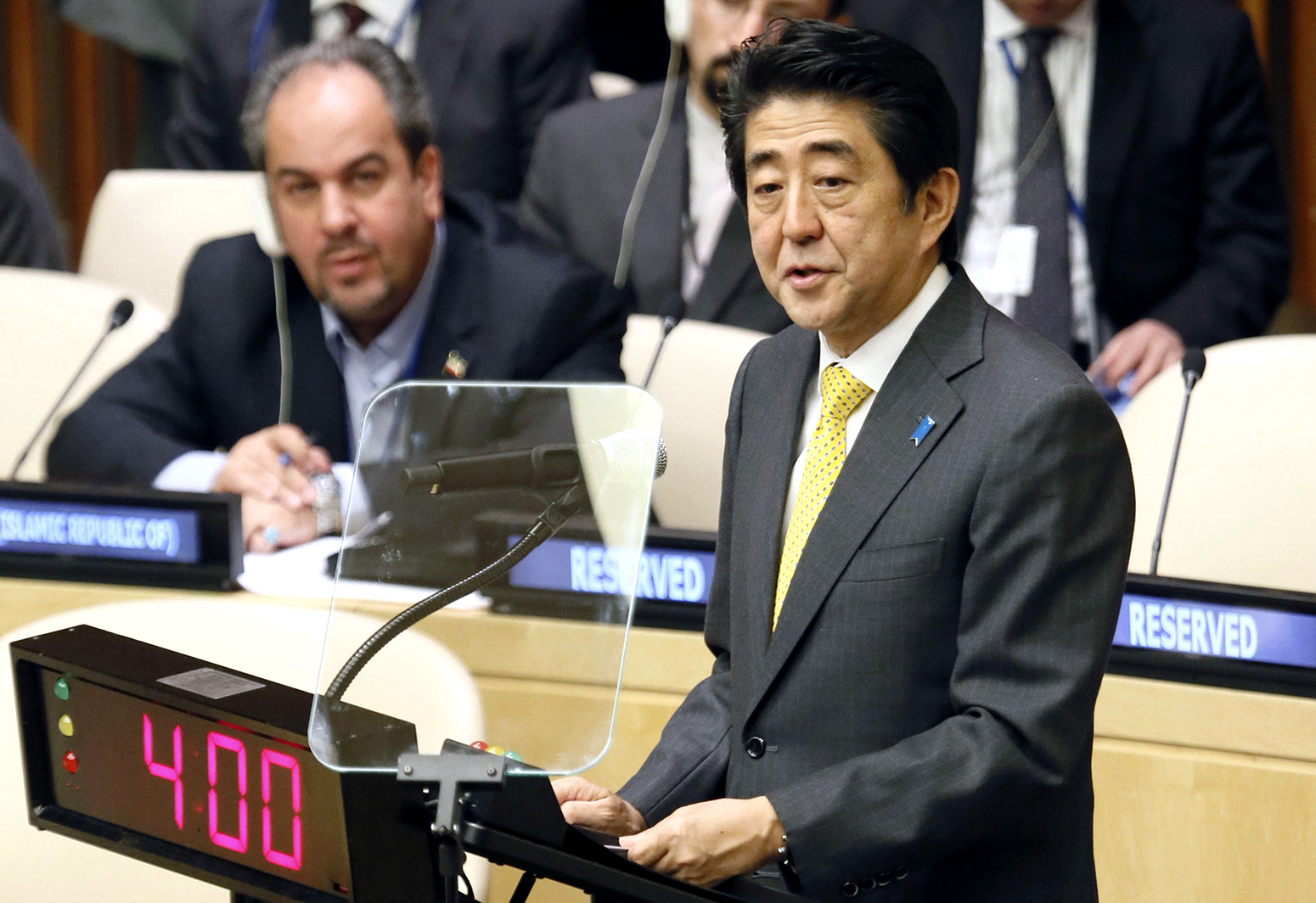
Japanese prime minister Shinzō Abe gives a speech at the UN summit on climate change in New York, in September 2014. Credit: Newscom/Alamy Stock Photo.
Climate Action Tracker (CAT) analysis rates Japan’spledgeas “highly insufficient”, meaning its promised emissions reductions are outside its “fair share” to be in line with the Paris Agreement. The pledge is not at all consistent with holding warming below 2C, let alone 1.5C, says CAT, and warming would reach 3-4C by 2100 if all government targets were akin to Japan’s.
Japan also intends to allow the use of LULUCF “credits” to meet its 2030 target, says CAT. This means improved land managements and re-vegetation would generate a credit which can be used to offset total emissions. This will effectively reduce the ambition of the target to 15% below 1990 levels, says CAT.
Meanwhile, coal plantconstruction plans“pose a serious risk to the government’s future mitigation efforts”, it says.
Japan’s per capita emissionsstood at10.2tCO2e in 2015. Japan’s NDC says its per capita emissions, along with progress in energy efficiency, show Japan is already “at the leading level among developed countries”. However, the UK and EU’s average per capita emissions were far lower in 2015, both at 7.7tCO2e. Japan’s NDC said it expects per capita emissions and energy efficiency to “improve” by around 20 to 40% by 2030.
It is worth noting that Japan’s population isalready fallingand this trend isexpected to continueover the coming decades. Per capita emissions will, therefore, fall less rapidly than overall emissions reductions.
Energy policy
在90%左右of Japan’s total GHG emissions come from energy-related activities, making these the most critical factor for its climate policy.
Energy policy in Japan lies under its Ministry of Economy, Trade and Industry (METI). This produces “basic energy plans” every three years (although thelast revisionwas made in 2014). A revision process for the new fifth plan has been ongoing since mid-2017 and is expected to be finalised by the end of summer 2018. [Update 3/7/2018: Japan todayapprovedits fifth basic energy plan. This left source targets unchanged from the draft plan discussed here.]
Last month, Japan released adraft version(in Japanese) of the plan. This outlined the intended mix of power sources for 2030, repeating plansfirst adoptedin 2015.
The electricity mix should include a 20-22% share ofnuclearand 22-24% share of renewables by 2030, it says. Coal should provide 26% of power and natural gas 27%. The plan also intends to reduce total electricity demand by 17% compared to a business-as-usual scenario.
The draft plan is the first to combine the renewables and nuclear figures to make a 44% “zero-emission electricity share”. It is also the first to outline plans to make renewables “major electricity sources”, or to discuss “decarbonisation”. However, it failed to increase Japan’s renewable targets, whichsomehad been pushing for.
The new basic energy plan is the first to include 2050 targets. It outlines multiple scenarios for 2050 based on different assumptions around renewables, fossil fuels, nuclear and hydrogen.
Nuclear
Nuclear began to play a significant role in Japan’s energy mix from the mid-1970s onwards. In the decades before 2010, it produced around a quarter of the country’s electricity, as the chart below shows.
Sources of electricity production in Japan, 1985-2017. Source: BPStatistical Review of World Energy 2018. Chart by Carbon Brief usingHighcharts.However, the 2011Fukushima disasterdrastically altered Japan’s view of nuclear energy. A tsunami caused by an earthquake off Japan’s northeast coast resulted in nuclear meltdown, with around 150,000 people evacuated due to the radiation threat. Following this, Japan quickly cut back on its use of nuclear energy and by 2013 it had shuttered all its nuclear plants. A large expansion of gas and oil provided the missing power.
In the wake of these changes, Japanannounced一个被削弱了的2013年国际气候承诺。Thenew goalwill mean a5% riseon 1990 emissions by 2020, while the previouspledgewould have reduced emissions 25% on 1990 levels. Japan isexpectedto overachieve its new target with current policies.
Japan’s government supports the re-commissioning of nuclear plantsto help tackleenergy supply strains, high energy prices and carbon emissions. The newdraft 2030 energy plandescribes nuclear as an “important base-load electricity source”.
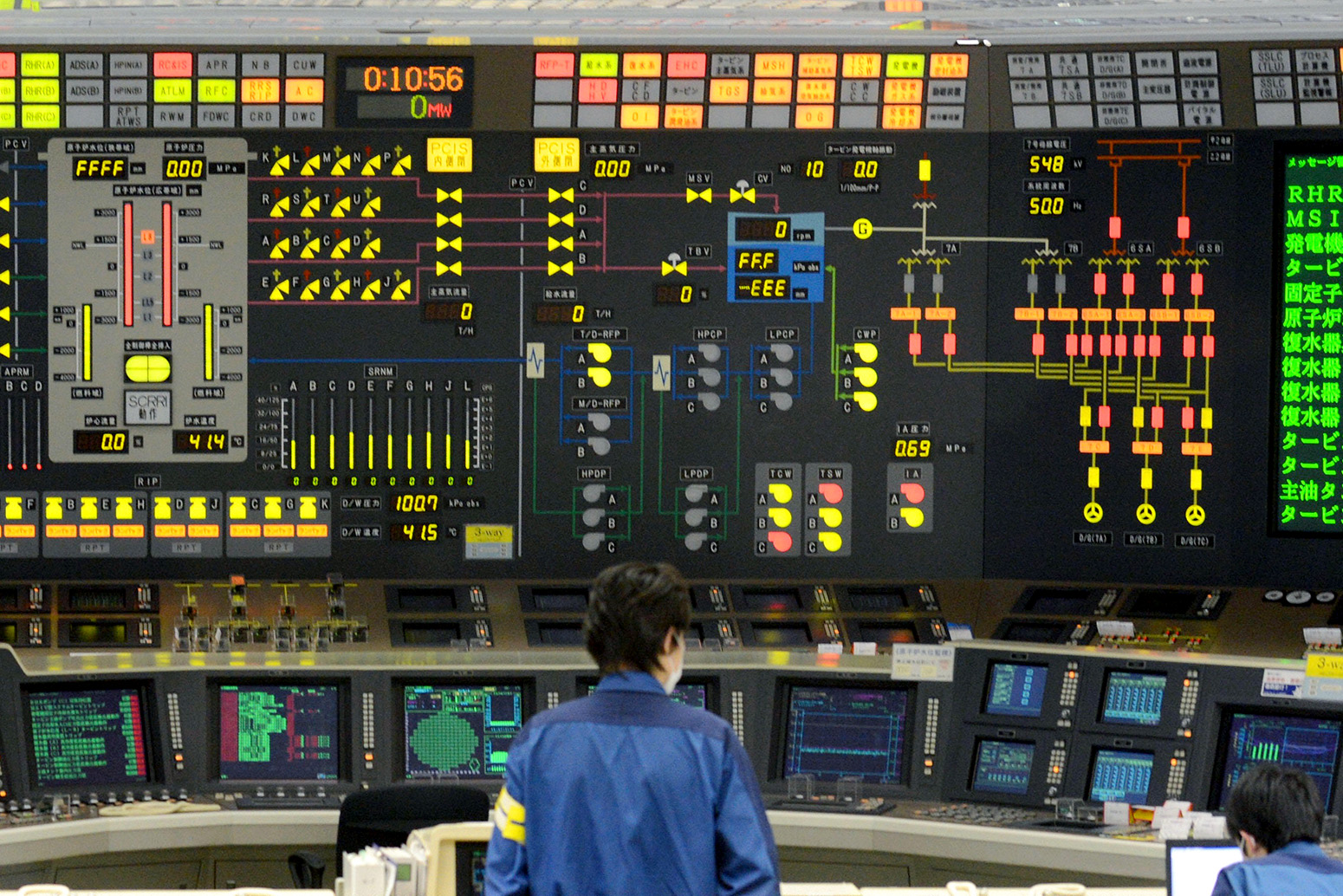
Kashiwazaki-Kariwa nuclear power plant in Niigata Prefecture, shortly after the reactor’s operation was suspended for routine checkup in March 2012. Credit: Newscom/Alamy Stock Photo.
Some nuclear plants havealready reopened近年来,核创eration isrising. However,only sevenof the country’s 42 operable plants are currently running and nuclear output remains at a fraction of its pre-2011 level. Government plans for increasing nuclear wouldmeanboth restarting nuclear plants and extending their lifetime.
Nuclear power remainscontestedin Japan, with a majority of peopleopposedto restarting reactors.Court ordersand public opposition havedelayedthe return of nuclear plants.
可再生能源
Japan has rapidly expanded its renewable power in recent years. Solar, wind and other non-hydro renewables produced 10% of Japan’s electricity in 2017, more than triple their production in 2012. Hydro has produced 6-8% of Japan’s electricity for decades.
By 2030, Japan expects 7% of its electricity to come from solar, 9% from hydro, 4% from biomass and 2% from wind. Together these would meet itstargetfor 22-24% share of renewables in the power mix, up from 18% in 2017. Despite apushtoseta higher 2030 renewables goal, this has reportedly beenlittle discussedin government so far.
Since 2012, renewables have been supported by Japan’sfeed-in tariff (FIT) law, which covers solar, wind, hydro, geothermal and biomass. The law obliges utilities to buy renewable electricity at a high guaranteed price, with costs paid by users.
The expansion of large-scale solar farms, in particular, has beenhelpedby the FIT law, although this has slowed slightly in the past few years. Japanrankedfourth globally for new capacity additions in 2017, with an estimated 7 gigawatts (GW) installed, despite a slight decrease in expansion in the past few years. Japan’s solar capacity now stands at over 49GW. This is the world’sthird largest, behind China and the US but ahead ofGermany.
The Japanese parliamentpassed changes to the FIT lawin 2016 to reduce its cost and better balance support between different technologies. In addition, the FIT system for large-scale solar projects was replaced with a new auction system. The firstauction, held in 2017, produced significantly lower solar prices than under the FIT system. However, solar prices remainhigherthan in many other countries.
Japan has relatively little wind capacity, whichcritics blameon a rigorousEnvironmental Impact Assessmentprocedure anddifficulty in accessing the grid. Government预测only expect 1.7% of power generation to come from wind by 2030. Japan addedaround 0.2GWof new wind capacity in 2017, bringing its total tojust over 3GW.
Geography has also been seen as a barrier to wind power development in Japan. For offshore wind, the deep waters near to its coast could limit development, although近岸wind farms and thedevelopmentoffloating offshorewind technology could overcome this.
Japanese offshore wind power has “tremendous potential”, according to a2017 reportfrom the Institute for Energy Economics and Financial Analysis (IEEFA). New legislation to help promote the development of offshore wind waspassedearlier this year.
Onshore wind also facesgeographical constraints, including population density,fragmentedelectricity grids, mountainous terrain, earthquakes and typhoons. Its contribution to the renewables mix isexpectedto peak shortly after 2030.
Coal
Coal power has risen in Japan since the Fukushima accident, supported in recent years byseveral policiesto make approval of coal plants easier and cheaper. Coal accounted for 34% of Japan’s electricity production in 2017, up from 27% in 2010.
Japan hasaround 45 GWof operatingcoal plants– the sixth largest fleet in the world – according to theGlobal Coal Plant Tracker. It also shows Japan has 18GW of new coal-fired plants in the planning or construction phases, the biggest coal power construction plans of any developed nation.
Note, though, that only 4GW of these plants are currently under construction and some of them may not get built.Nearly a quarterof the new plants planned by the end of 2017 have beencancelledor shelved this year.

Tsuruga power plant, Japan. Credit: Joel Abroad/Flickr(CC BY-NC-SA).
In order to align with the Paris Agreement goals, Japan now needs to shift focus to how to mostly phase out all coal plants by 2030,accordingto scientific NGOClimate Analytics. It pointedto the UK, which is set to shut down its last coal plant by 2025, as an example of a successfulcoal phase-out.
Japan’s coal plants are thought to bethe most efficientin the world. However,efficiencystandards will not come close to bringing emissions down to what is needed under the Paris Agreement, Climate Analytics says.
Japan has not had any large-scale coal mining since itdwindledto almost nothing in 2002. It imported arecord amountof coal last year,primarilyfrom Australia. Japan’s banks are also well known forfinancingcoal developments abroad, especially in South East Asia.
Oil and gas
Japan is the world’slargestliquefied natural gas (LNG) importer and electricityaccountsfor the majority of gas consumption. Following the Fukushima disaster, gas-based electricity became the largest contributor to fill the gap from closed nuclear plants. It increased by around a third between 2010 and 2012, remaining at high levels ever since.
The governmentexpectsnatural gas to supply 27% of the nation’s power in 2030, down from 40% today.
Japan is also the world’sthird largestoil consumer and importer, behind the US and China. The use of oil to produce electricity fell over the decades up to 2010. Its use doubled in the years following Fukushima, but has since dropped to its lowest ever level, supplying 5% of electricity in 2017. The governmentexpectsit to supply 3% of power in 2030.
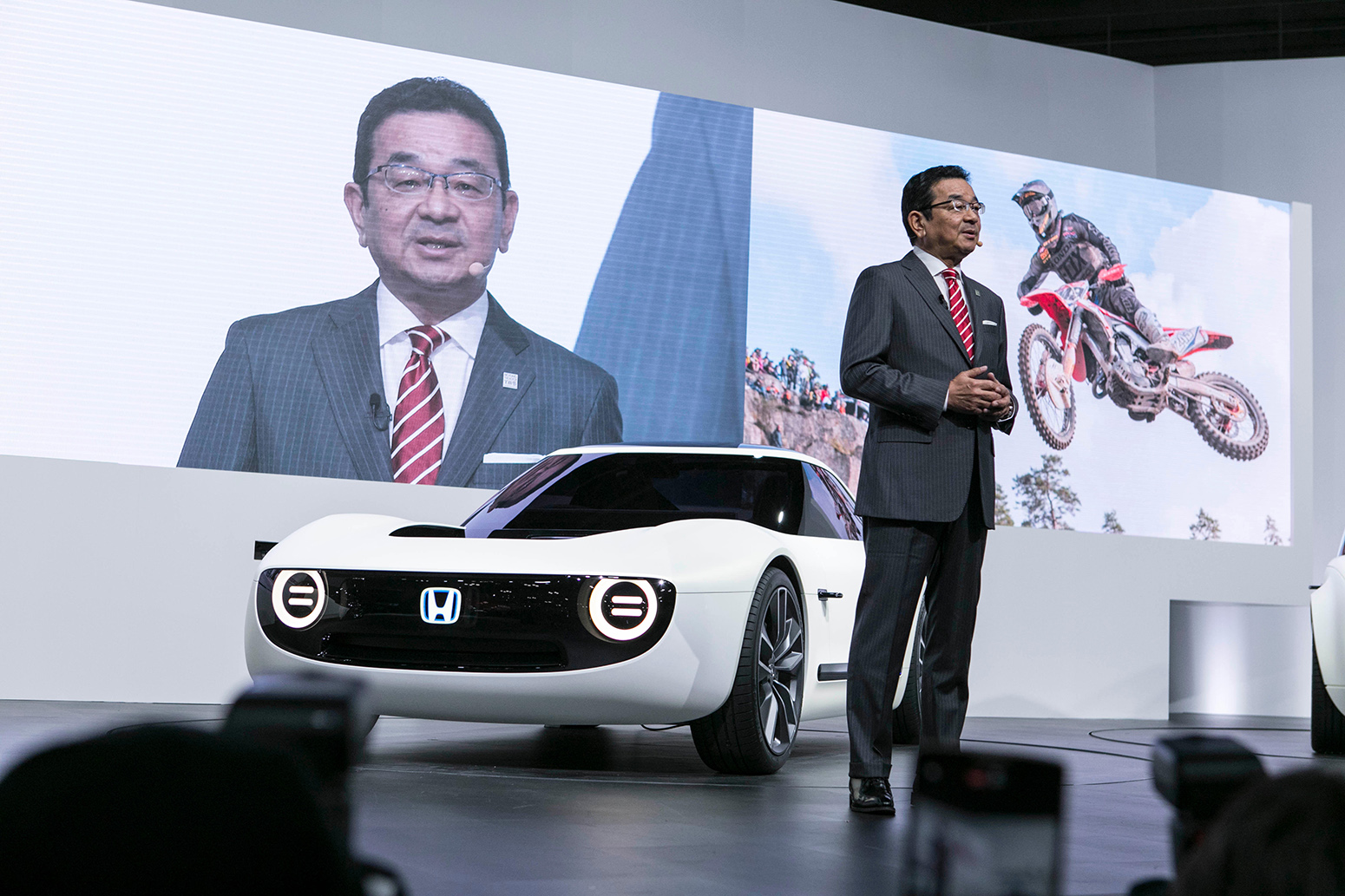
The president of Honda, Takahiro Hachigo, pictured after presenting its new concept cars at the 45th Tokyo Motor Show. Credit: Yuichiro Tashiro /Alamy Live News.
Japan’s transport and manufacturing sectors rely heavily on oil, which the governmentnoteshas highest geopolitical risk to procurement among all fossil fuels.
Japan’s government has set out a“hydrogen society” vision, which it plans to showcase at the 2020Tokyo Olympic Games. This includes atargetof putting 40,000 hydrogen-powered vehicles on the road by 2020 and doubling the number of fuelling stations to 160.
Japan has alsopromotedtheuptakeof electric and hybrid cars usingsubsidiesand infrastructure support, and had a fleet of150,000in 2016. Toyota, the country’s biggest automaker, has longpromotedits first hydrogen-powered car, but more recentlyannounced开发一系列的计划electric vehicles.
Climate laws
Japan’s climate policytakes placeunder itsAct on Promotion of Global Warming Countermeasures. This waspassed in 1998and aims to reduce human-caused global warming by “formulating a plan for attaining targets”. It commits the state, local governments and companies to develop emission reduction plans.
Themost recentstate plan was released in May 2016. This also serves to “clarif[y] the pathway” to achieving Japan’s NDC goal. It sets out “estimated emissions” reductions in different sectors to meet the 2030 target and policies to get there.
The biggest cuts are expected to come from the commercial, residential and transport sectors. It outlines plans to improve the energy efficiency of buildings through 100% use of LED lights and installation of 5.3m fuel cells in homes by 2030. Electric or fuel cell vehicles should make up 50-70% of new sales by 2030, it says, while renewables should be expanded “to the maximum extent possible”.
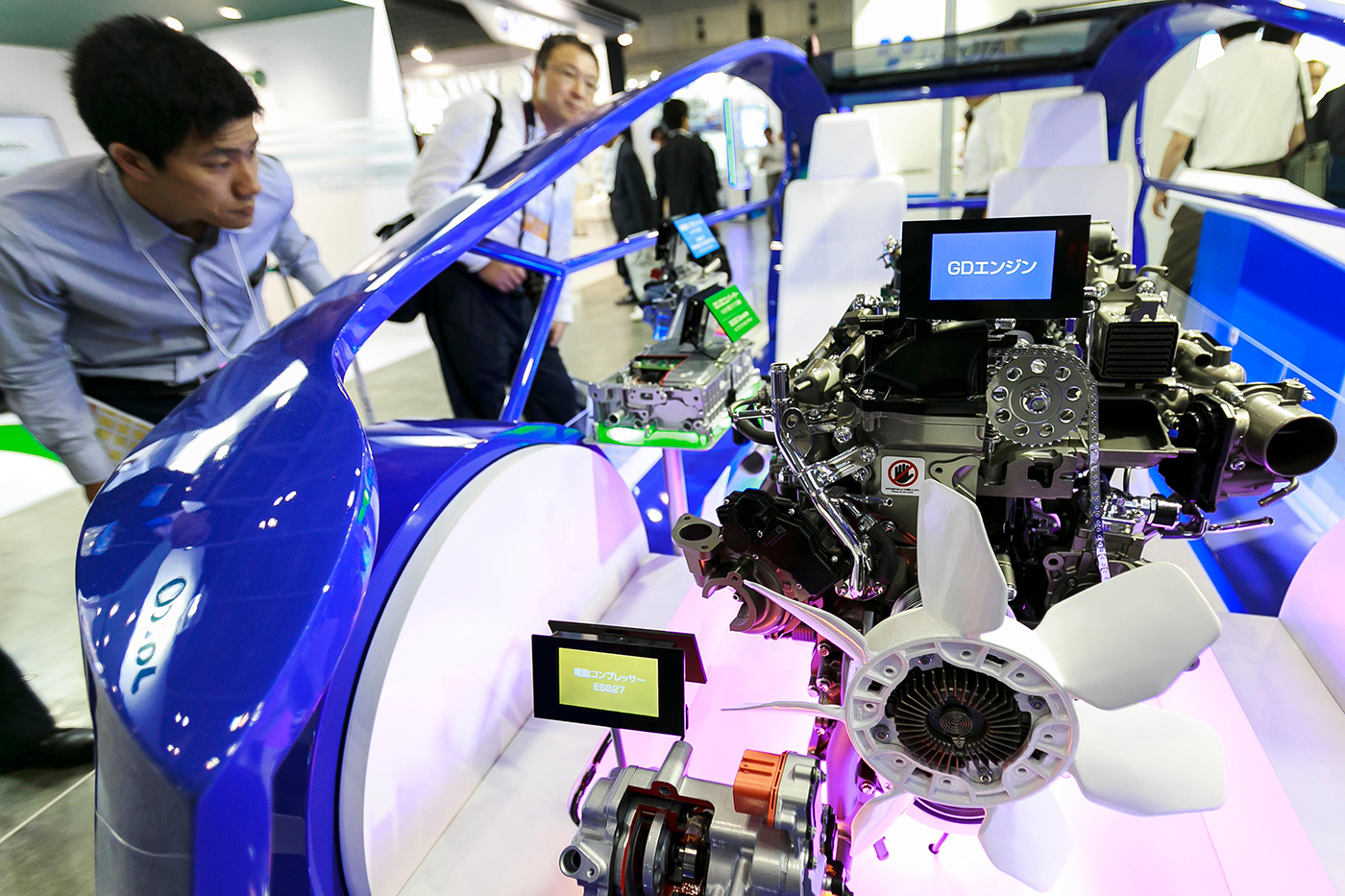
Visitors look at the hydrogen fuel cell vehicle system of the Toyota Mirai at an exposition in Yokohama, Japan, 25/05/2016. Credit: Rodrigo Reyes Marin/AFLO/Alamy Live News
The country’slawon the “rational use of energy”, enacted in 1979 due to theoil crisis, aims to promote effective use of energy, including in transport and industry. The governmentprides itselfon itsenergy efficiency improvementssince then and aims to improve energy consumption efficiency 35% by 2030, compared to 2012 levels.
In 2015, Japan passedregulationmaking energy efficiency standards for large buildings mandatory for the first time. It alsoaimsto reduce the net energy consumption of new homes and buildings to zero by 2030.
Japan has a long-term goal to reduce its greenhouse gases by 80%, though it gives no baseline year for this. The goal was set back in 2012 and re-stated in the 2016 climateplan.
It is nowdevelopingalong-term emissions strategyup to 2050, due to be submitted to the UNFCCC by 2020. Japan is expected to finalise it before hosting theG20 summitin May 2019.
CAT hasexpressed concernover Japan’s long-term strategy. It says that two government ministries – the Ministry of the Environment (MOEJ) andMETI– have published separate reports on the strategy with “fundamentally different directions”. Itsays:
“The MOEJ focuses on how to achieve the 80% by 2050 reduction target domestically, and emphasises a need for the early introduction of a fully-fledged carbon pricing scheme.
In complete contrast, the METI emphasises the difficulty of achieving the 80% reduction domestically and focuses instead on Japan’s international contribution to global emissions reductions. The METI report is also critical about any introduction of a full-fledged, nationwide carbon pricing in the near-term.”
Japan’s environment ministry is currently working on acarbon pricingproposal, althoughopposition remainsin parts of the government. Last year, Japan’s environment minister called carbon pricing “the most efficient tool” to help achieve the 2050 target.
In 2012, Japan implemented a碳排放税on oil, gas and coal imports, with revenues going towards measures to curb CO2 emissions. The price of this remains very lowat under $3 per tonne CO2e.
Impacts and adaptation
Japan is vulnerable to several impacts of climate change, includingsea level rise,coastal erosion, more intensetyphoonsand summer droughts.
Some research has shown the effects of climate change already being felt in Japan. One 2013paperfound several ecological changes occurring due to climate change, including delays in the first springtime appearance of some insects.
Meanwhile, theJapan Metrological Agencysays long-term temperature rises due to global warming may havecontributedto this year’s early blooming of cherry trees. Theculturally significant树已经开花day earlier every decade since 1953, the agency says.
In March 2015, Japan’s Central Environment Council released a 108-pageimpact assessmentof the current and possible future impacts of climate change across seven sectors, from agriculture to human health.

Cherry Blossom in Gyoen National Garden, Shinjuku, Tokyo, Japan. Credit: Oleksiy Maksymenko Photography/Alamy Stock Photo.
The report noted, for example, a projected decline in the quality of rice due to rising temperatures. It also said Japan’s current vulnerability to floods means more severe rainfall conditions due to climate change could have “considerably high” impacts.
The government followed up this impact assessment in November 2015 with its 107-pageNational Adaptation Plan. This outlined how climate adaptation in the seven sectors should be “mainstream[ed]” into government policy. The next plan is due in or before 2020.
In February 2018, Japan’s cabinet通过一项法案to address the damage from already locked-in effects of climate change. The billcommitsthe environment ministry to assessing climate change impacts every five years and municipalities to developing adaptation plans. The bill isexpectedto be enacted by Japan’s two parliamentary chambers this summer.
Japan isobligedto provide climate finance to other countries, due to itsAnnex IIstatus at the UNFCCC. It is the third biggest donor to multilateral climate funds after the US and UK, Carbon Briefyabo亚博体育app下载showed last year.
Most significantly, it has pledged $1.5bn to the Green Climate Fund (GCF), established to leverage climate finance towards the$100bn per yearpromised by developed countries by 2020.
This means Japan is now, in effect, the GCF’slargest donor. The US, which had pledged $3bn to the fund, hassaidit now plans not to follow through on $2bn of this.
-
The Carbon Brief Profile: Japan
-
Everything you need to know about Japan’s climate and energy policy
-
Japan plans to increase its renewable and nuclear power, but also to build significant numbers of new coal power plants


